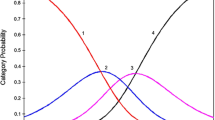Abstract
The Autism Spectrum Quotient (AQ) quantifies autistic traits in adults. This paper adapted the AQ for children (age 9.8–15.4 years). Three groups of participants were assessed: Group 1: n=52 adolescents with Asperger Syndrome (AS) or high-functioning autism (HFA); Group 2: n=79 adolescents with classic autism; and Group 3, n=50 controls. The adolescents with AS/HFA did not differ significantly from the adolescents with autism but both clinical groups scored higher than controls. Approximately 90% of the adolescents with AS/HFA and autism scored 30+, vs. none of the controls. Among the controls, boys scored higher than girls. The AQ can rapidly quantify where an adolescent is situated on the continuum from autism to normality.

Similar content being viewed by others
References
APA. (1994). DSM-IV diagnostic and statistical manual of mental disorders, 4th ed. Washington DC: American Psychiatric Association
Asperger H. (1944). Die “Autistischen Psychopathen” im Kindesalter Archiv fur Psychiatrie und Nervenkrankheiten 117:76–136
Attwood T. (1997). Asperger’s Syndrome UK Jessica Kingsley
Baron-Cohen S. (2002). The extreme male brain theory of autism Trends in Cognitive Sciences 6:248–254
Baron-Cohen S., Hammer J. (1997). Is autism an extreme form of the male brain? Advances in Infancy Research 11:193–217
Baron-Cohen S., Richler J., Bisarya D., Gurunathan N., Wheelwright S. (2003). The Systemising Quotient (SQ): An investigation of adults with Asperger Syndrome or high functioning autism and normal sex differences Philosophical Transactions of the Royal Society, Series B, Special issue on “Autism: Mind and Brain” 358:361–374
Baron-Cohen S., Wheelwright S. (2003). The Friendship Questionnaire (FQ): An investigation of adults with Asperger Syndrome or high functioning autism, and normal sex differences Journal of Autism and Developmental Disorders 33:509–517
Baron-Cohen S., Wheelwright S. (2004). The Empathy Quotient (EQ). An investigation of adults with Asperger Syndrome or high functioning autism, and normal sex differences Journal of Autism and Developmental Disorders, 34:163–175
Baron-Cohen S., Wheelwright S., Skinner R., Martin J., Clubley E. (2001). The Autism Spectrum Quotient (AQ): Evidence from Asperger Syndrome/high functioning autism, males and females, scientists and mathematicians Journal of Autism and Developmental Disorders 31:5–17
Ehlers S., Gillberg C., Wing L. (1999). A screening questionnaire for Asperger Syndrome and other high-functioning autism spectrum disorders in school-age children Journal of Autism and Developmental Disorders 29:129–141
Klin A., Volkmar F., Sparrow S., Cicchetti D., Rourke B. (1995). Validity and neuropsychological characterization of Asperger Syndrome: Convergence with nonverbal learning disabilities syndrome Journal of Child Psychology and Psychiatry 36:1127–1140
Scott F., Baron-Cohen S., Bolton P., Brayne C., (2002). The CAST (Childhood Asperger Syndrome Test): Preliminary development of UK screen for mainstream primary-school children Autism 6(1):9–31
Wakabayashi A., Baron-Cohen S., Wheelwright S., (2004). The Autism-Spectrum Quotient (AQ) Japanese version: Evidence from high-functioning clinical group and normal adults The Japanese Journal of Psychology 75:78–84
Wechsler D., (1958). Sex differences in intelligence : The measurement and appraisal of adult intelligence Baltimore Williams & Wilking
Wing L., (1981). Asperger Syndrome: A clinical account Psychological Medicine 11:115–130
Woodbury-Smith, M., Robinson, J., & Baron-Cohen, S. (2005). Screening adults for Asperger Syndrome using the AQ: diagnostic validity in clinical practice. Journal of Autism and Developmental Disorders, 35, 331–335
ACKNOWLEDGMENTS
The authors were supported by a grant from the MRC and the Lurie-Marks Foundation, during the period of this work. Rosa Hoekstra was supported by a grant from the HsN Hersenstichting Nederland, the Bekker-La Bastide Fund and the Schuurman Schimmel van Outeren Foundation.
Author information
Authors and Affiliations
Corresponding author
Appendix 1: The Adolescent AQ
Appendix 1: The Adolescent AQ
Rights and permissions
About this article
Cite this article
Baron-Cohen, S., Hoekstra, R.A., Knickmeyer, R. et al. The Autism-Spectrum Quotient (AQ)—Adolescent Version. J Autism Dev Disord 36, 343–350 (2006). https://doi.org/10.1007/s10803-006-0073-6
Published:
Issue Date:
DOI: https://doi.org/10.1007/s10803-006-0073-6




